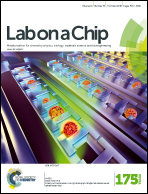Enhanced energy harvesting by concentration gradient-driven ion transport in SBA-15 mesoporous silica thin films†
Abstract
Nanofluidic energy harvesting systems have attracted interest in the field of battery application, particularly for miniaturized electrical devices, because they possess excellent energy conversion capability for their size. In this study, a mesoporous silica (MPS)-based nanofluidic energy harvesting system was fabricated and selective ion transport in mesopores as a function of the salt gradient was investigated. Aqueous solutions with three different kinds of monovalent electrolytes—KCl, NaCl, and LiCl—with different diffusion coefficients (D+) were considered. The highest power density was 3.90 W m−2 for KCl, followed by 2.39 W m−2 for NaCl and 1.29 W m−2 for LiCl. Furthermore, the dependency of power density on the type of cation employed indicates that the harvested energy increases as the cation mobility increases, particularly at high concentrations. This cation-specific dependency suggests that the maximum power density increases by increasing the diffusion coefficient ratio of cations to anions, making this ratio a critical parameter in enhancing the performance of nanofluidic energy harvesting systems with extremely small pores ranging from 2 to 3 nm.


 Please wait while we load your content...
Please wait while we load your content...